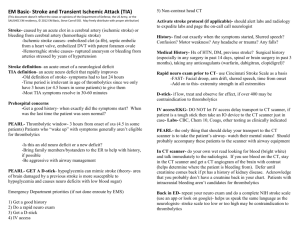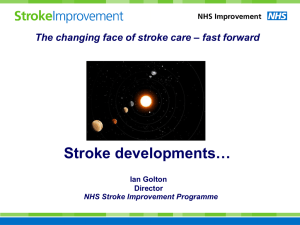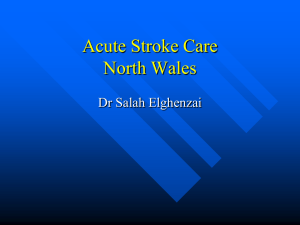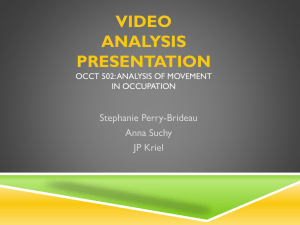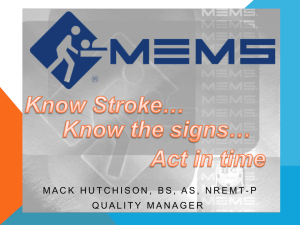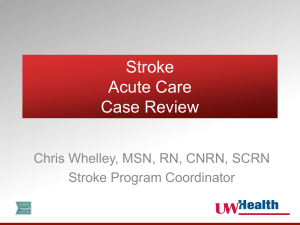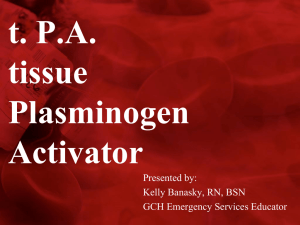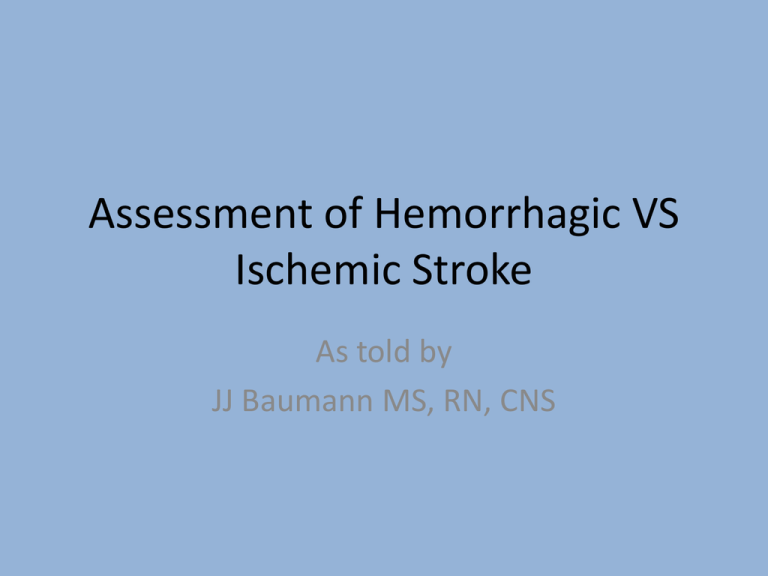
Assessment of Hemorrhagic VS
Ischemic Stroke
As told by
JJ Baumann MS, RN, CNS
Cerebral Vessel Vignettes
Couple of Clots
• 70 year old female
• Smoker
• Mopping the floor
and started feeling
dizzy and tired
• Witnessed sudden
onset of aphasia,
right sided weakness
12: 15 - last seen normal
12:40 - stroke code activated – pre hospital
EMS states right side weakness
12:45 - Handsome paramedic arrives with
patient who only has a right facial droop
Time to relax?
A. Don’t cancel stroke code. Let’s give tPA.
B. Cancel stroke code, but still get imaging.
C. Scold EMS for not knowing facial droop from
complete weakness.
D. Get EMS call back number, the charge nurse
also thinks he is hot.
CODE STEMI
Déjà vu
Cardiac cath lab – heart fixed.
On the table, she suddenly stops
talking and has right sided weakness.
Stenting the Left ICA
48 Hours Later
Her requests:
1. Thank paramedic that brought her to the
hospital so quickly
2. Let her go home now
My request:
1. Stop smoking!
What is
this?
200,000 cigarette packs, the same
number of Americans who die
every six months due to smoking.
Smoking
Under Pressure
62 year old male
PMHx:
Diabetes
Hypertension
Renal issues?
Medications:
2 blood pressure
medications
1 oral antiglycemic
aspirin
Intracranial Hemorrhage
9 am: sudden headache
and left sided weakness
Now what?
A.
B.
C.
D.
Get frequent neuro exams?
Have neurosurgery fix it?
Stop the bleeding?
Find the cause?
Primary Hemorrhage
• Amyloid
– Lobar
• HTN
-
Thalamus
Basal Ganglia
Pontine
Cerebellum
Secondary Hemorrhage
•
•
•
•
•
Coagulopathies
Tumor
AVM / aneurysm
Illicit drug use
Excess EtOH
Getting sleepy…
Frequent neuro checks
Patient becoming more sleepy
Head of bed > 30 degrees
Done
Blood pressure
Titrating nicardipine gtt to keep
SBP < 160
Fever control
No fever
Sedation
Patient calm
Surgical or medical?
Deep territory, medical
management
CT scan
• Bleed is stable
• More swelling
• Ventricles – no change
Hyperosmolar Therapy
Mannitol
3% NaCl
280-300 mOsm/kg
Isotonic
0.45% Na
D5W
300 to 320 mOsm/kg
hypertonic
hypotonic
DO IT FOR THE BRAIN !
•
•
•
•
•
•
•
Neuro exam
Blood pressure control
Head of bed
Hyperosmolar therapy
Sedation
Fever control
Prepare for EVD placement
Stroke Code on ortho
•
•
•
•
72 yo male
Hip fx
POD 2
Sudden onset
left facial droop
& slurred
speech
Increased risk of MI/ PE 1 week after surgery and stroke 1-2
weeks after surgery.
Patient is at increased risk of stroke after surgery if:
They have had a stroke.
They have atrial fibrillation.
Risky Business?
•
•
•
•
Hypertension
Diabetes – type 2
Overweight
There was something
else, but….
Exacerbation of Old Symptoms
• Metabolic
– Electrolytes
– Medications
– Hypercarbia
• Infectious
– WBC
– Fever
Exacerbation of stroke symptoms by infection and metabolic
perturbations – A diffusion-weighted MRI study
S. Iyadurai, K. Knievel, M. Flaster (St. Louis, Phoenix, Las Vegas, US)
If a Tree Falls in the Forest…
87 year old female
EMS: Trauma! AMS following a
non-witnessed fall at about 7 pm
Family: Patient got up to get ready
for bed. There was a loud thud in
the bedroom, and she was found
"down" by her vanity table
gripping tightly unto her walker
and chair and "shaking."
Trauma Team: She sustained
multiple lacerations, the worst of
which is on her R forearm.
Medications
• diltiazem (CARDIZEM CD) 120 mg sustained
release capsule
• losartan (COZAAR) 25 mg tab
• furosemide (LASIX) 20 mg tab
• pantoprazole (PROTONIX) 40 mg delayed
release tablet
• acetaminophen (TYLENOL) 325 mg tab
• Multi vitamin
• Paroxysmal AF
• CVA with residual R
visual field neglect
• High blood pressure
• Congestive heart failure
• Dementia
Seeing the Trees for the Forest
• Not clear if fall was
mechanical
• Fall not witnessed
Pre-syncope?
Seizure?
TIA?
X-rays, labs, spot EKG, MRI…
Multiple acute infarctions posterior
circulations .
Posterior circulation – Vertebral and
Basilar
• Cranial nerve deficits
–
–
–
–
–
–
•
•
•
•
•
3rd nerve palsy
Nystagmus
Vertigo
Dysphagia
Dysarthria
Diplopia
Cortical blindness / visual field loss
Truncal or limb ataxia
Spastic paresis
Quadriplegia
Weakness of facial, lingual, and pharyngeal muscles
Now what?
Acute treatment?
- tPA
- NIR
Prevention?
- ASA
- Plavix / Aggrenox
- Coumadin / Pradaxa
CHADS2 Score
in Atrial Fibrillation
CHAD2 item
Points
Congestive heart failure
1
Hypertension (systolic >140 mmHg)
1
Age greater than 75 years
1
Diabetes
1
Prior cerebral ischemia / TIA
2
Annual Stroke Risk
CHADS2 Score
0
1
2
3
4
5
6
Yearly risk of stroke
1.9%
2.8%
4.0%
5.9%
8.5%
12.5%
18.2%
BF Gage et al. Validation of clinical classification schemes for predicting stroke.
Results from the national registry of atrial fibrillation. JAMA 2001 285: 2864-2870.
Balancing Act
Two GI Bleeds
requiring
hospitalization
in past 3
months
CHADS Score is 5,
12.5% chance per
year will have a
stroke
Grandma
82 year-old woman who lives with her
daughter’s family. She needs help with
groceries and preparing meals, but she
is otherwise independent and enjoys
life. Grandkids love her.
Treat?
1:45 pm
Unable to talk, right
hemi
(NIH – 22)
2:30 pm
EMS arrives
Stroke Code
Number of patients who benefit (and are harmed) per 100
patients treated with tPA
Grandma
Lansberg et al. Stroke 2009
4:13 pm: tPA complete!
Why has she not improved?
Cath lab?
Completed her stroke?
tPA did not work?
Neuro Interventional Radiology
-Intra-arterial t-PA
-Mechanical devices
-Merci
-Penumbra
-Solitaire
NIHSS
5-9
10-14
Chance large
vessel occl
34%
42%
>15
100%
NIH > 12
95% chance large vessel occlusion
Completed the Stroke?
The Ischemic Penumbra
Core Infarct
Ischemic Penumbra:
zone of salvageable
tissue surrounding
core infarct
4:15 pm: Start Stroke MRI with DWI and PWI
… but a large PWI lesion
A small DWI lesion
Mean MTT 8
Mean XE-CT CBF 15
Mean Tmax 4s
4:46 pm: Case start
5:38 pm: The vessel is open
Before Therapy
After Therapy
Courtesy of Maarten Lansberg, MD
Home is Where the Brain Is!
Walks home with
family. Without
treatment would
likely have been
severely disabled
waiting for nursing
home placement.
Courtesy of Maarten Lansberg, MD
Questions?





